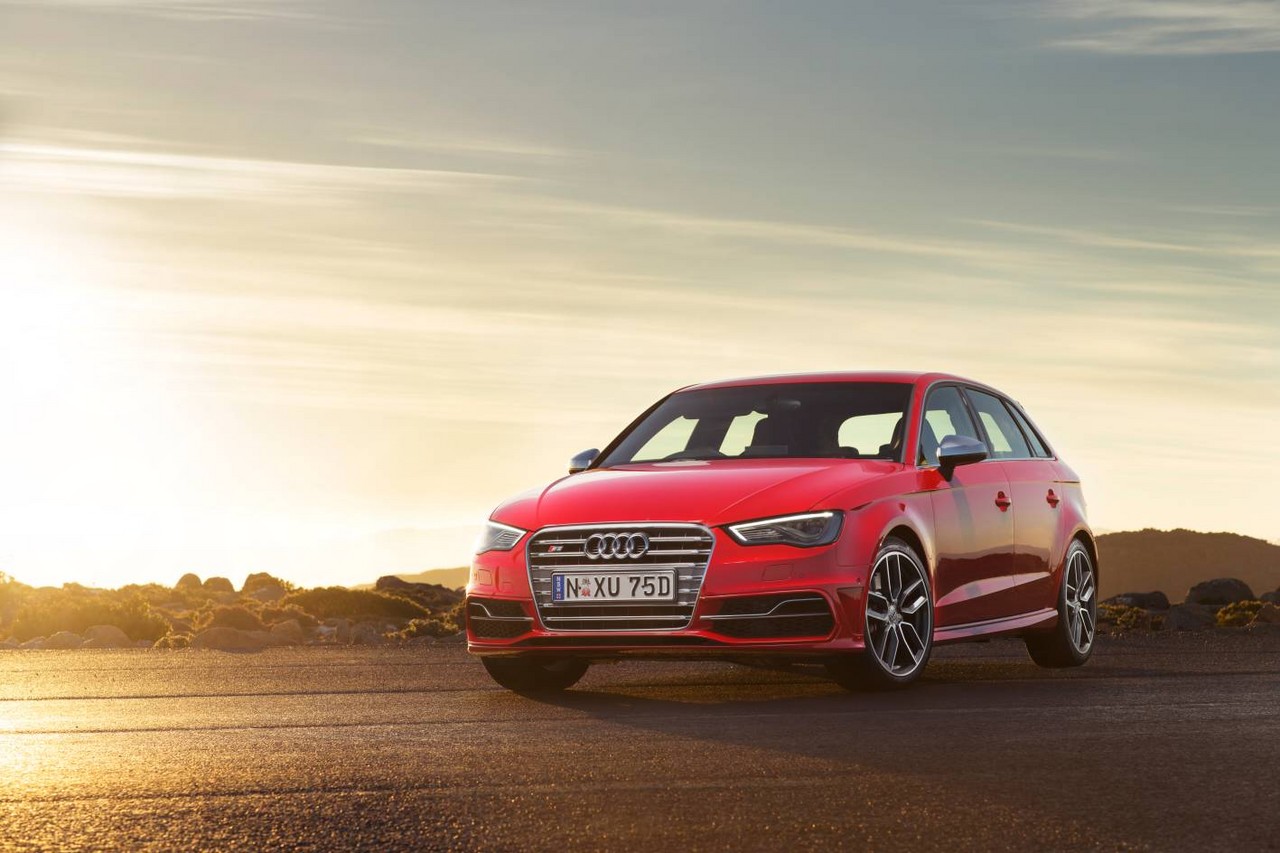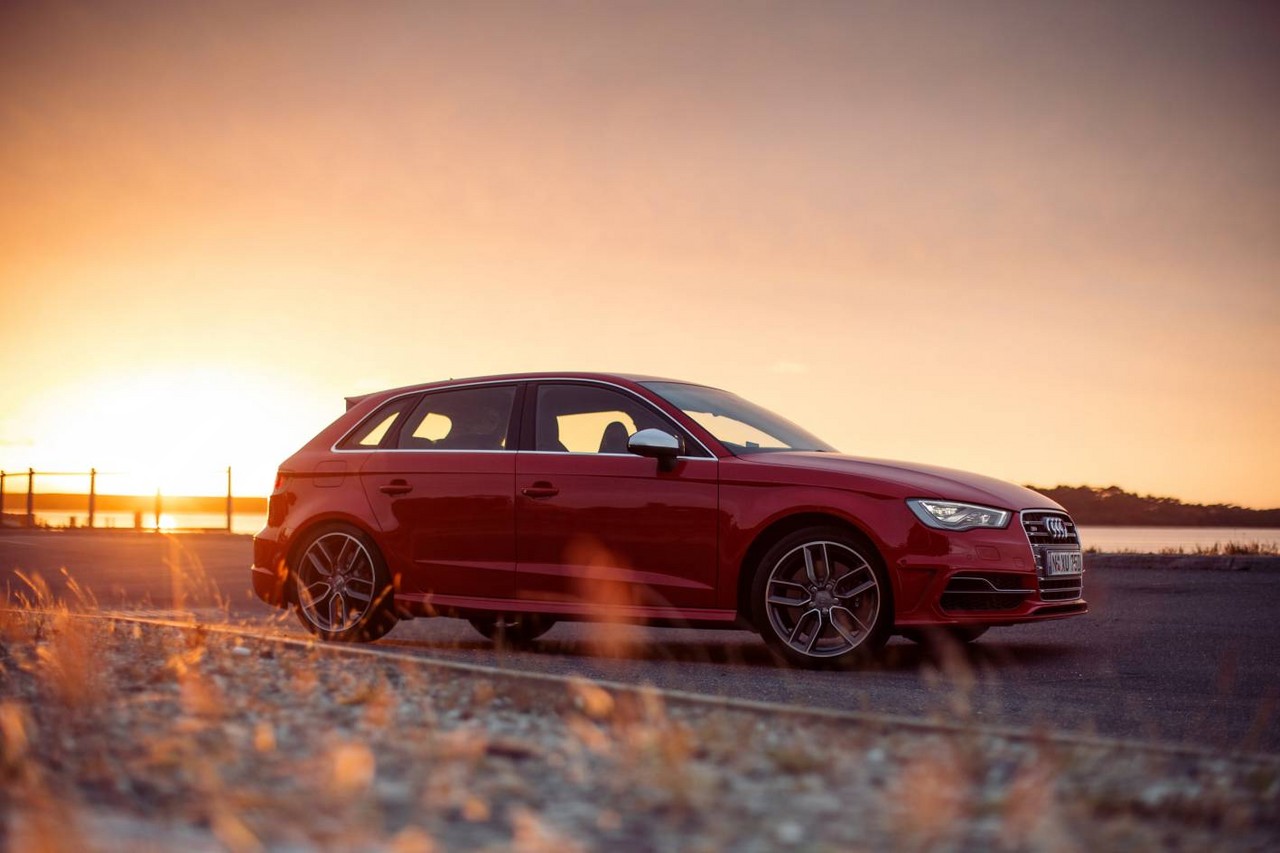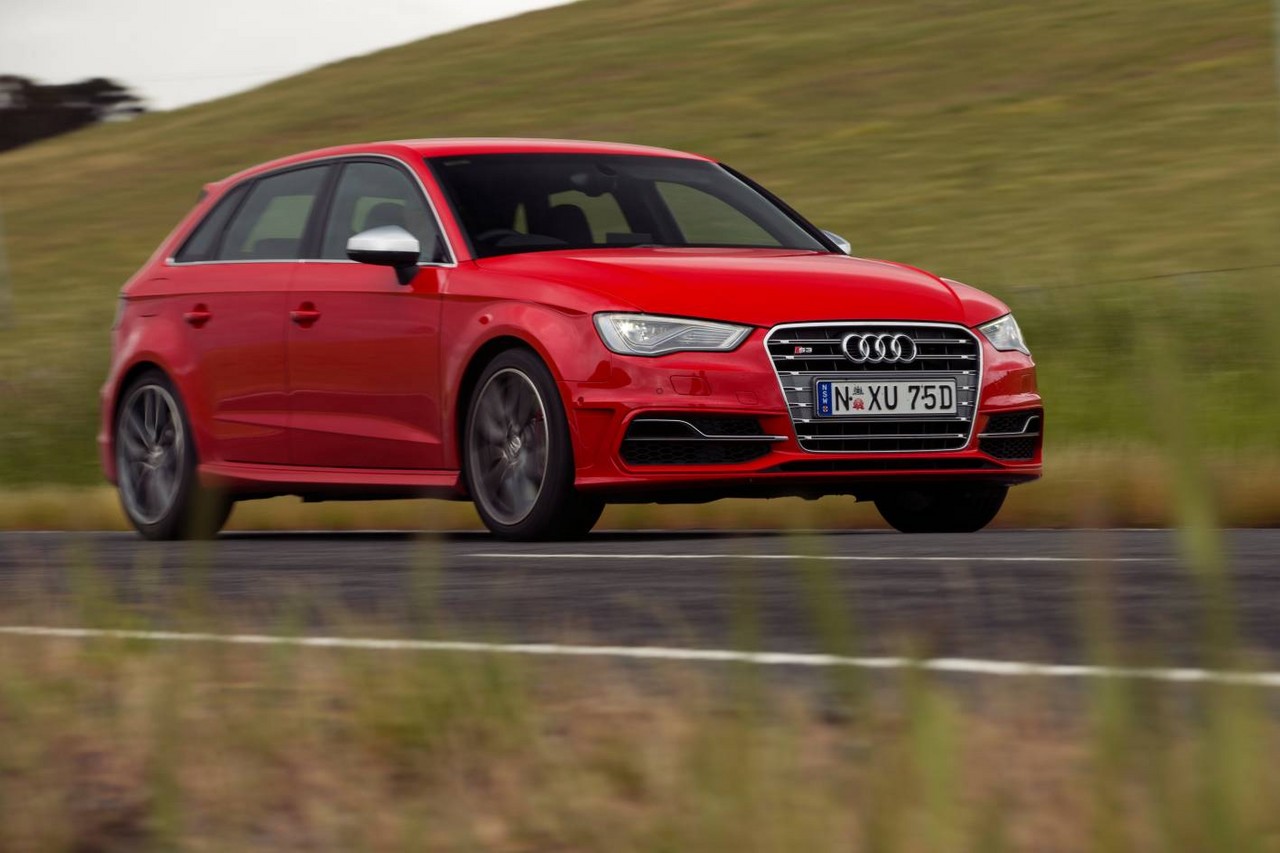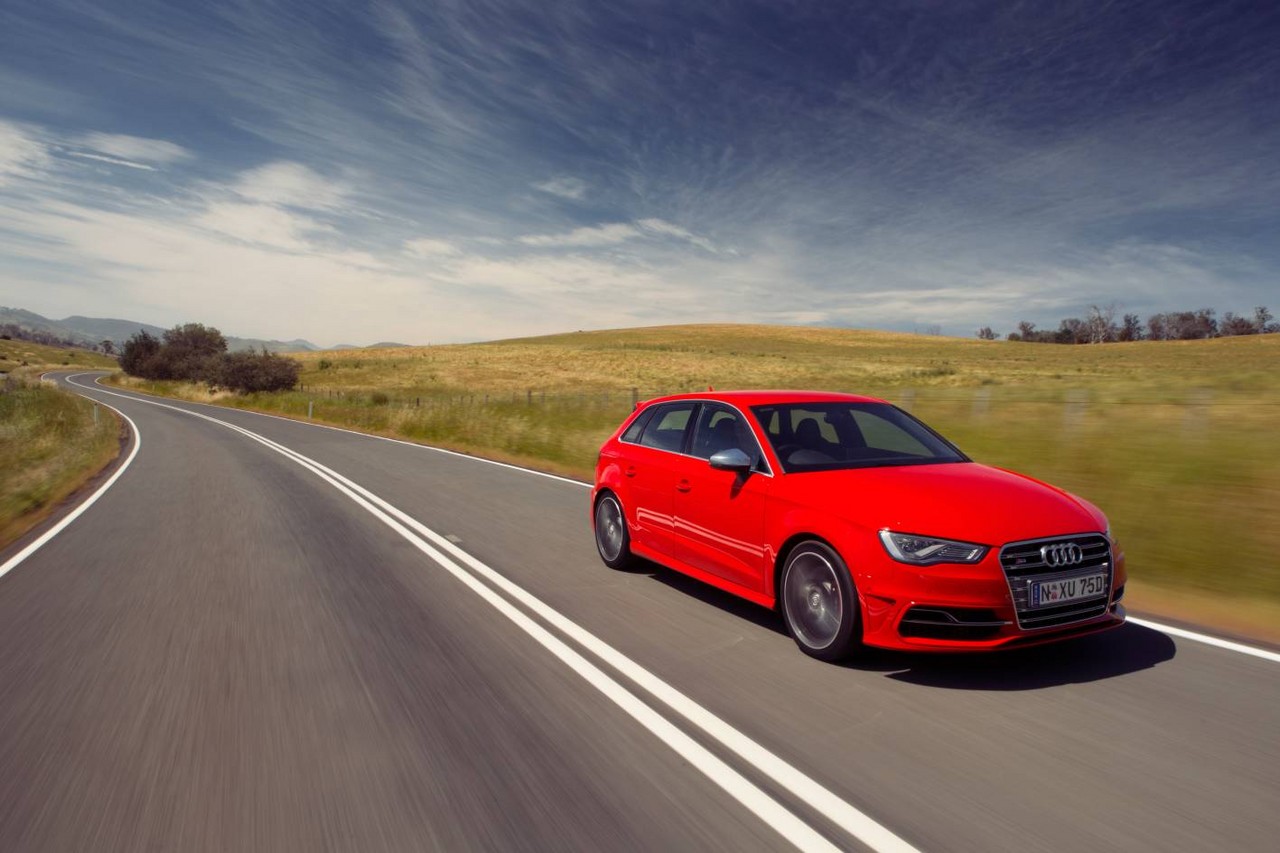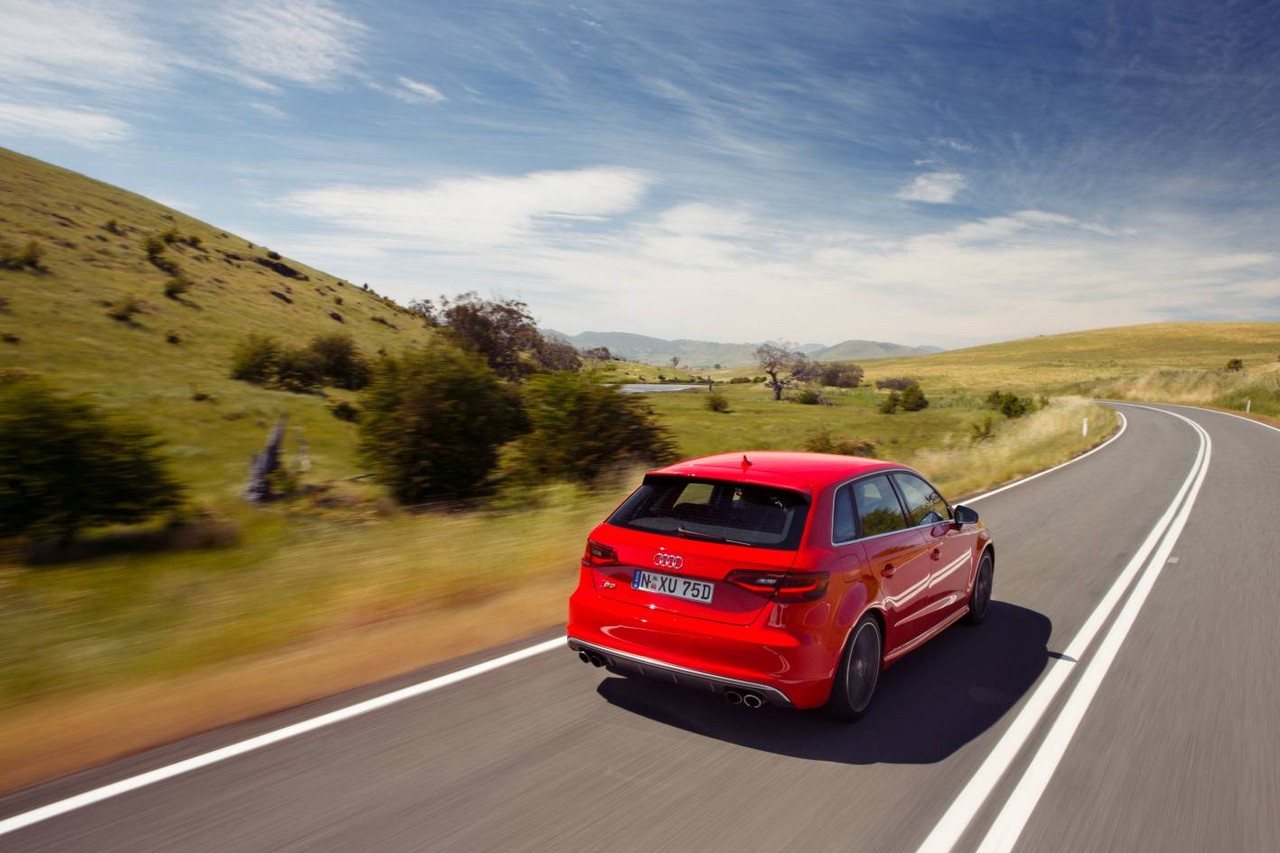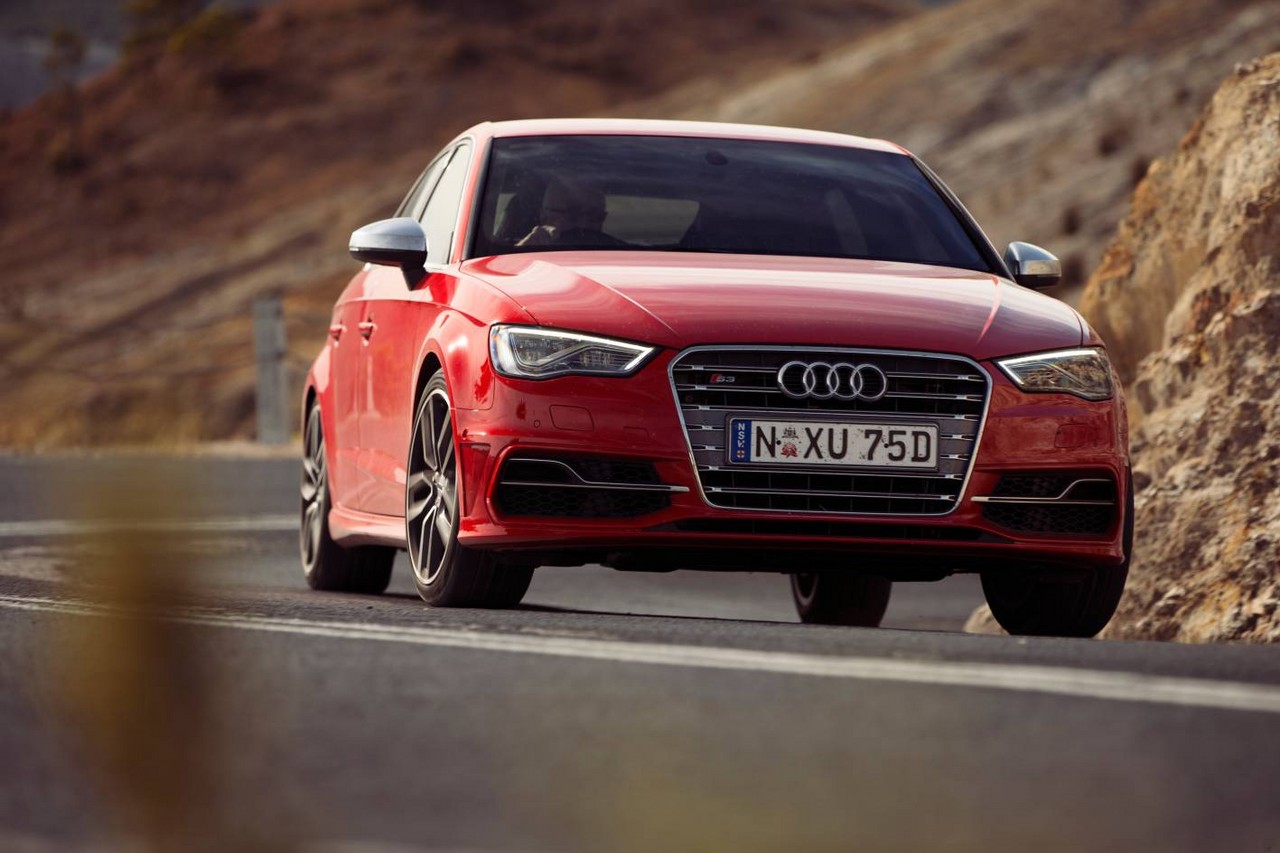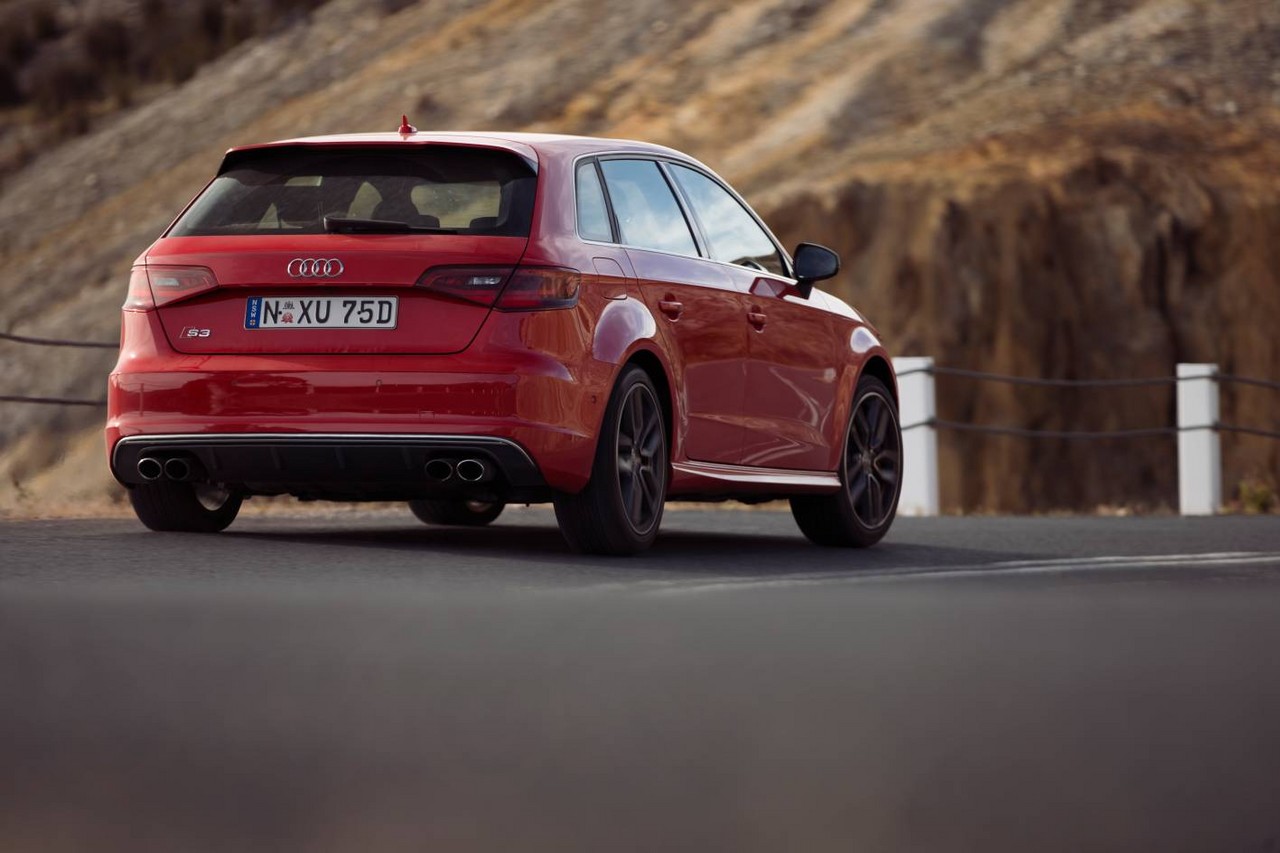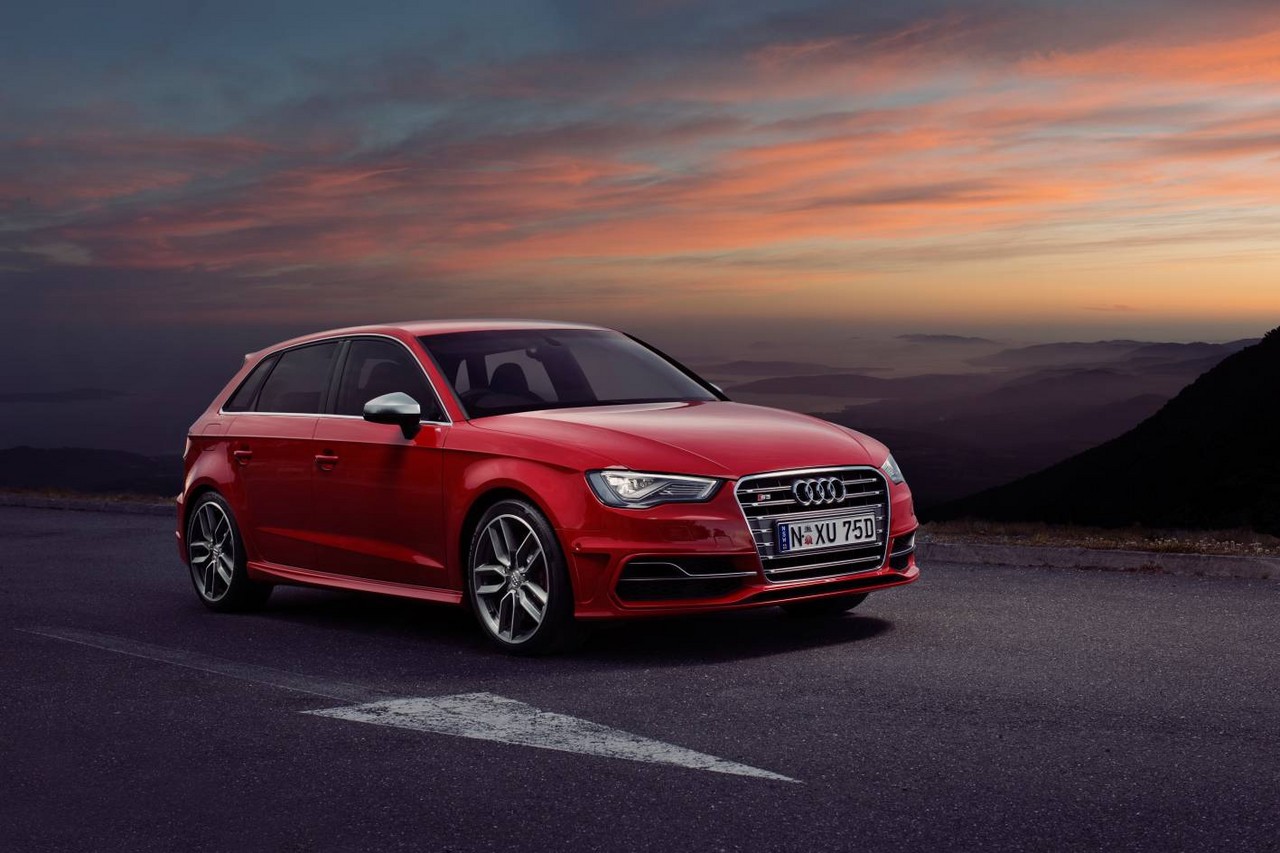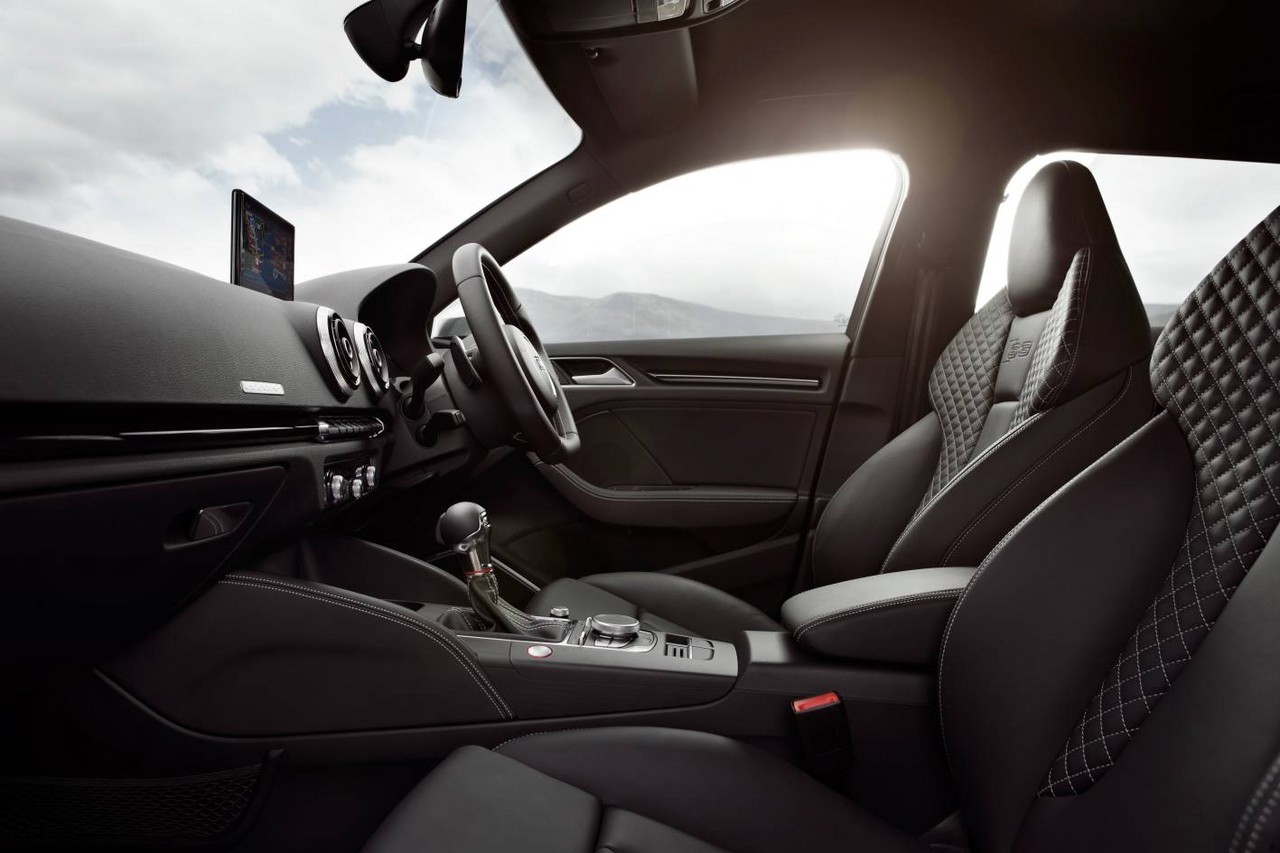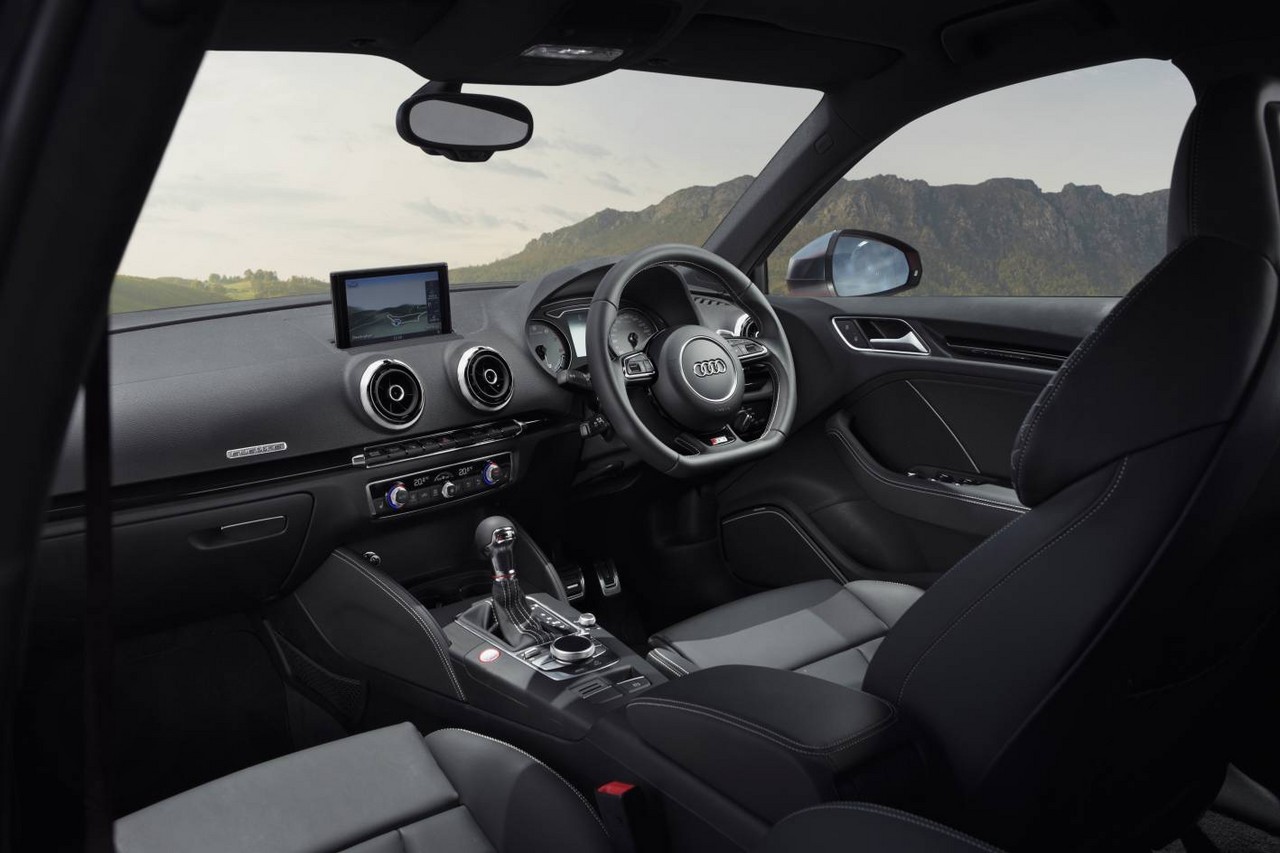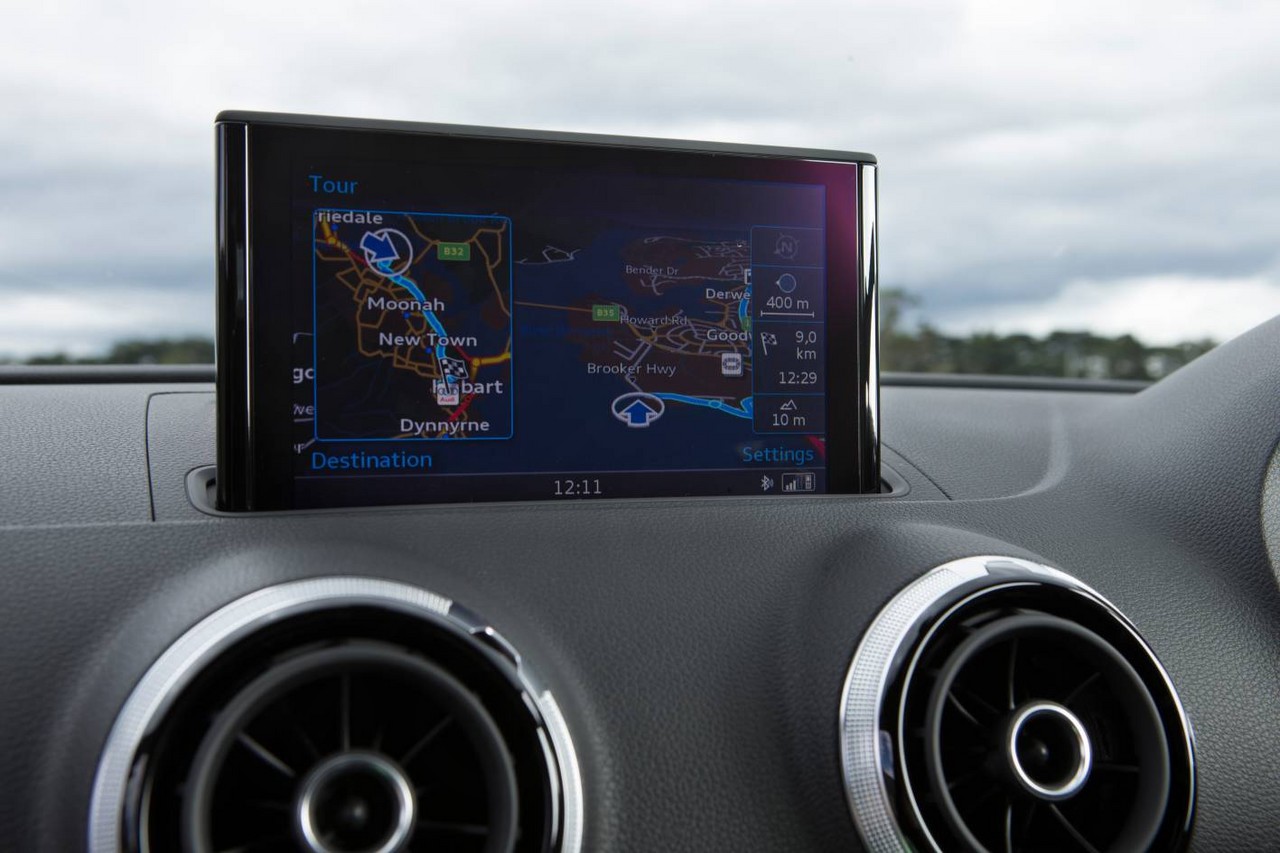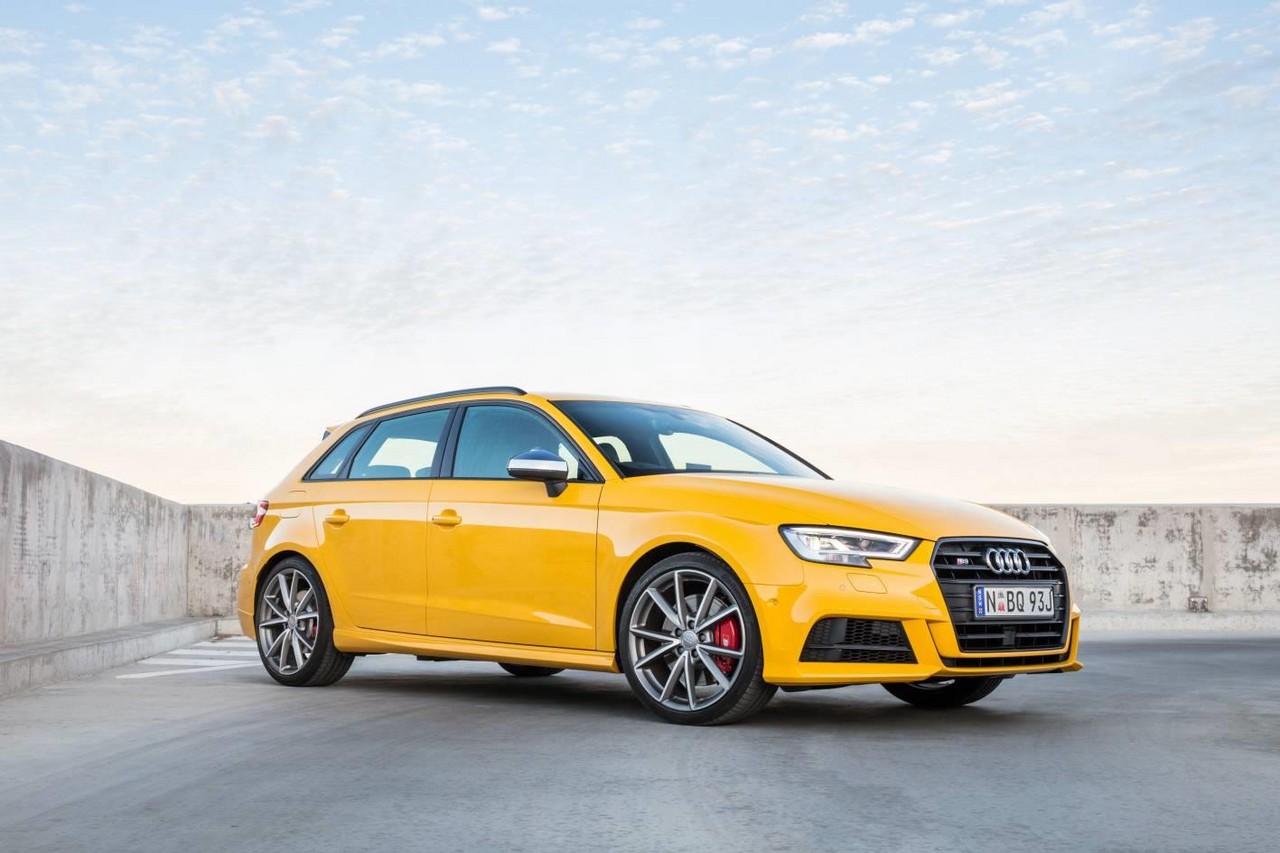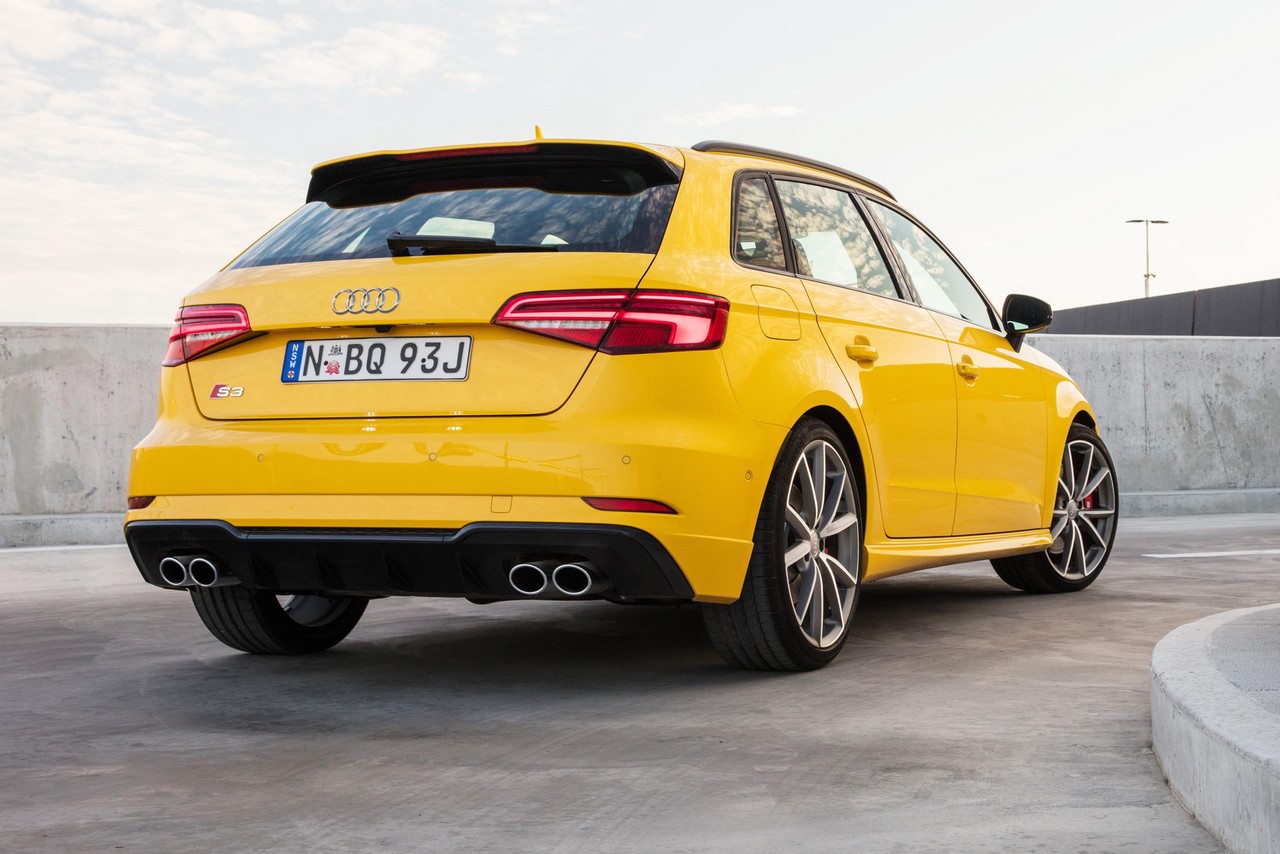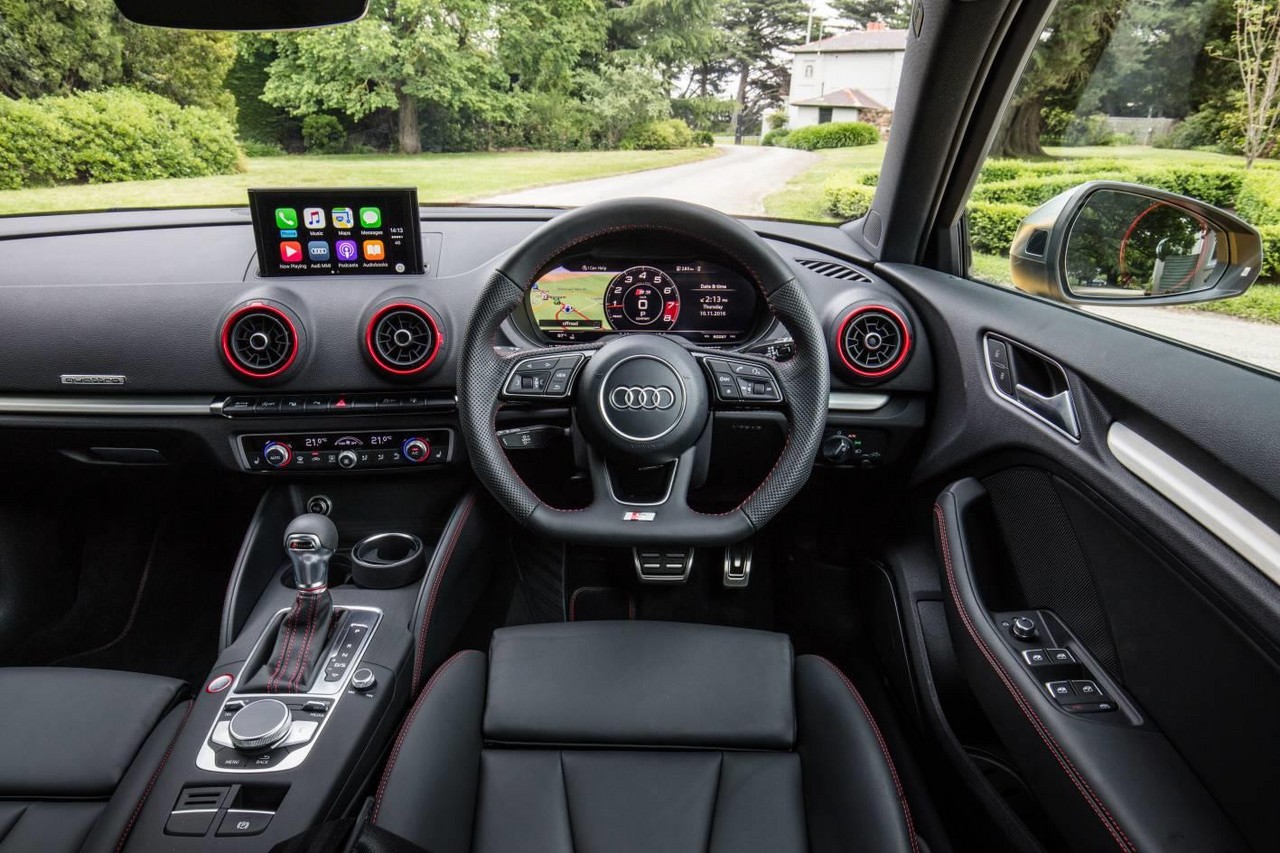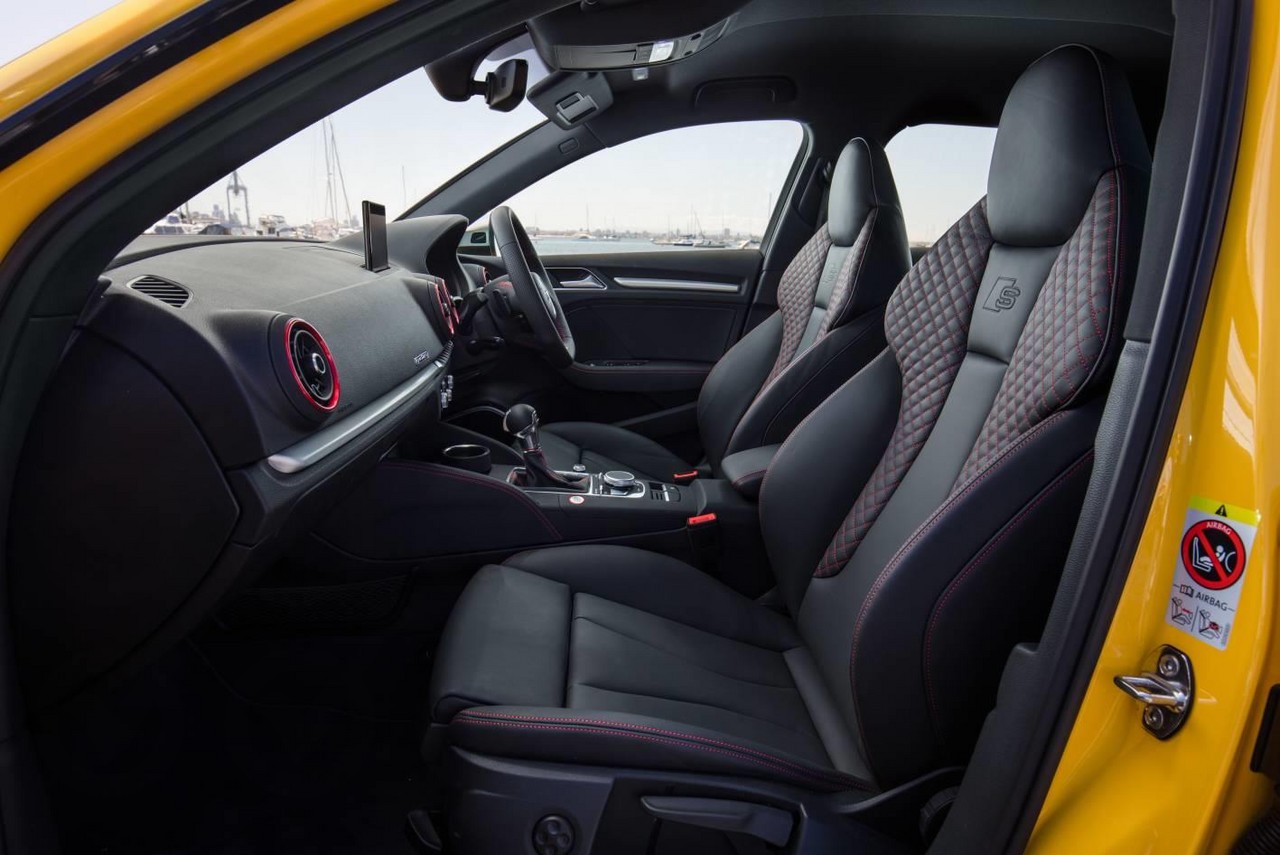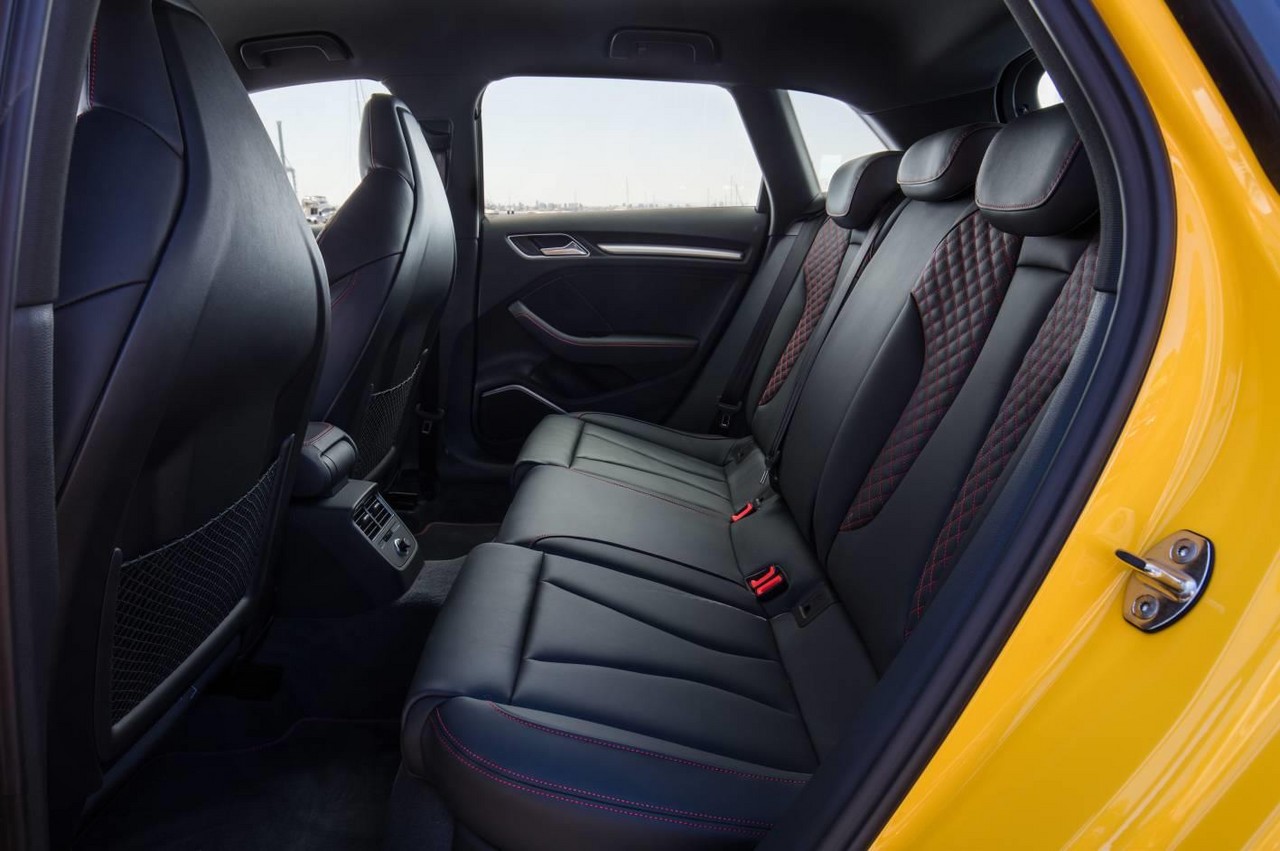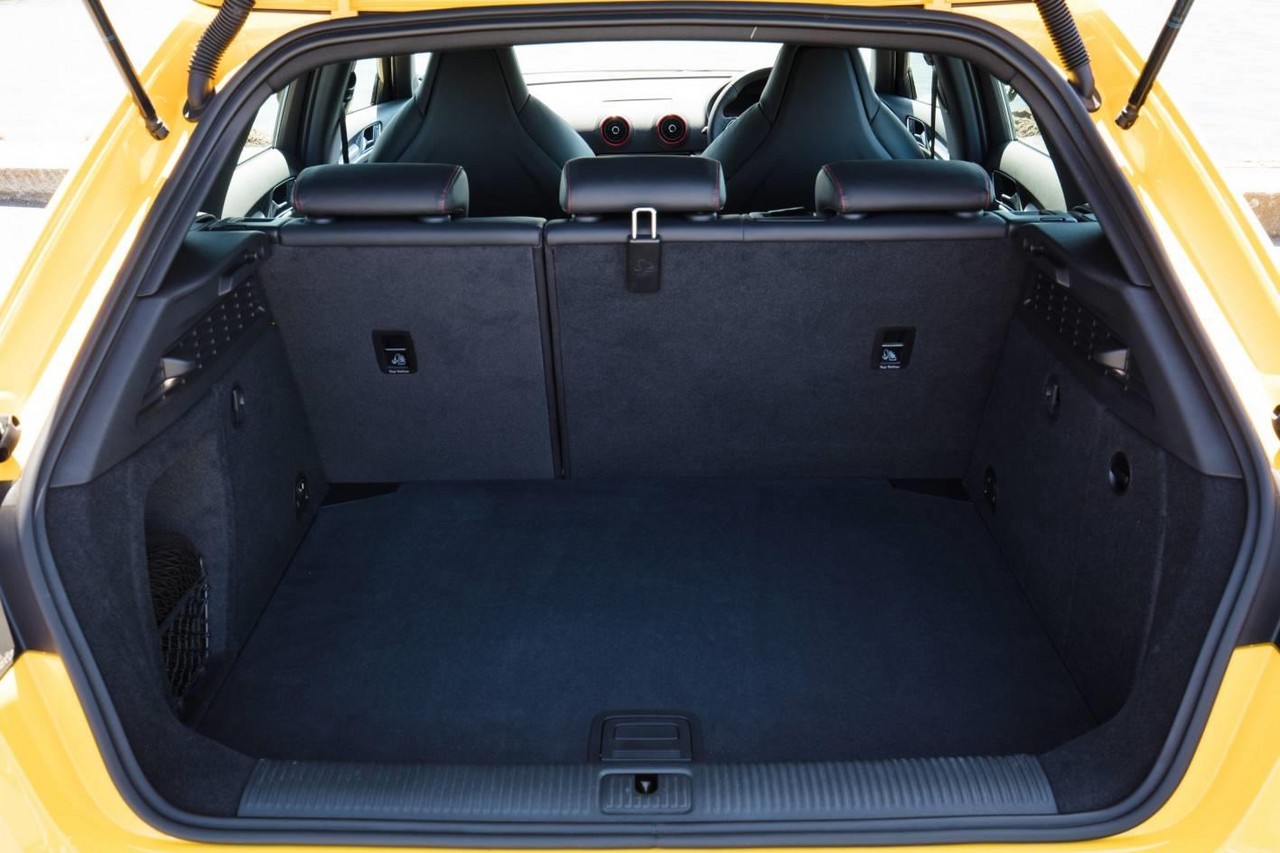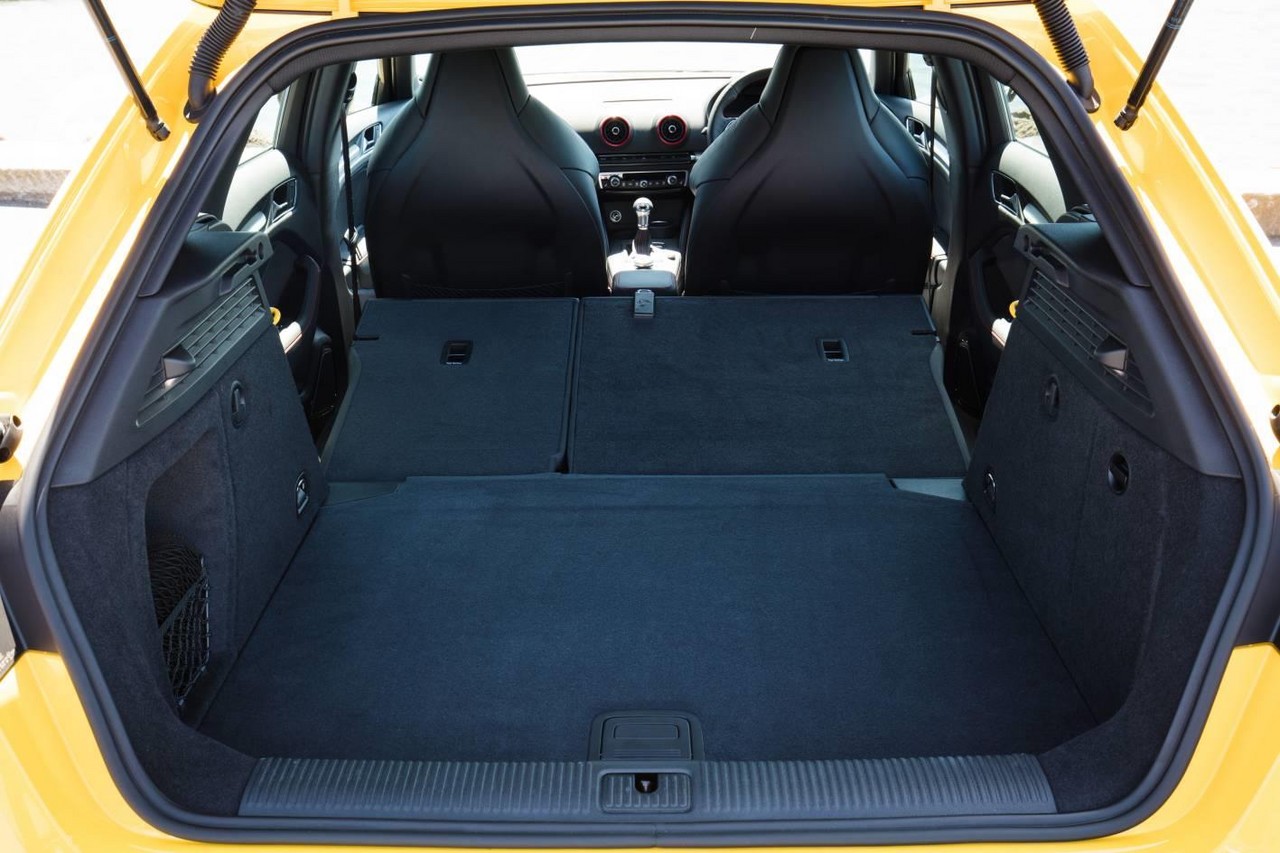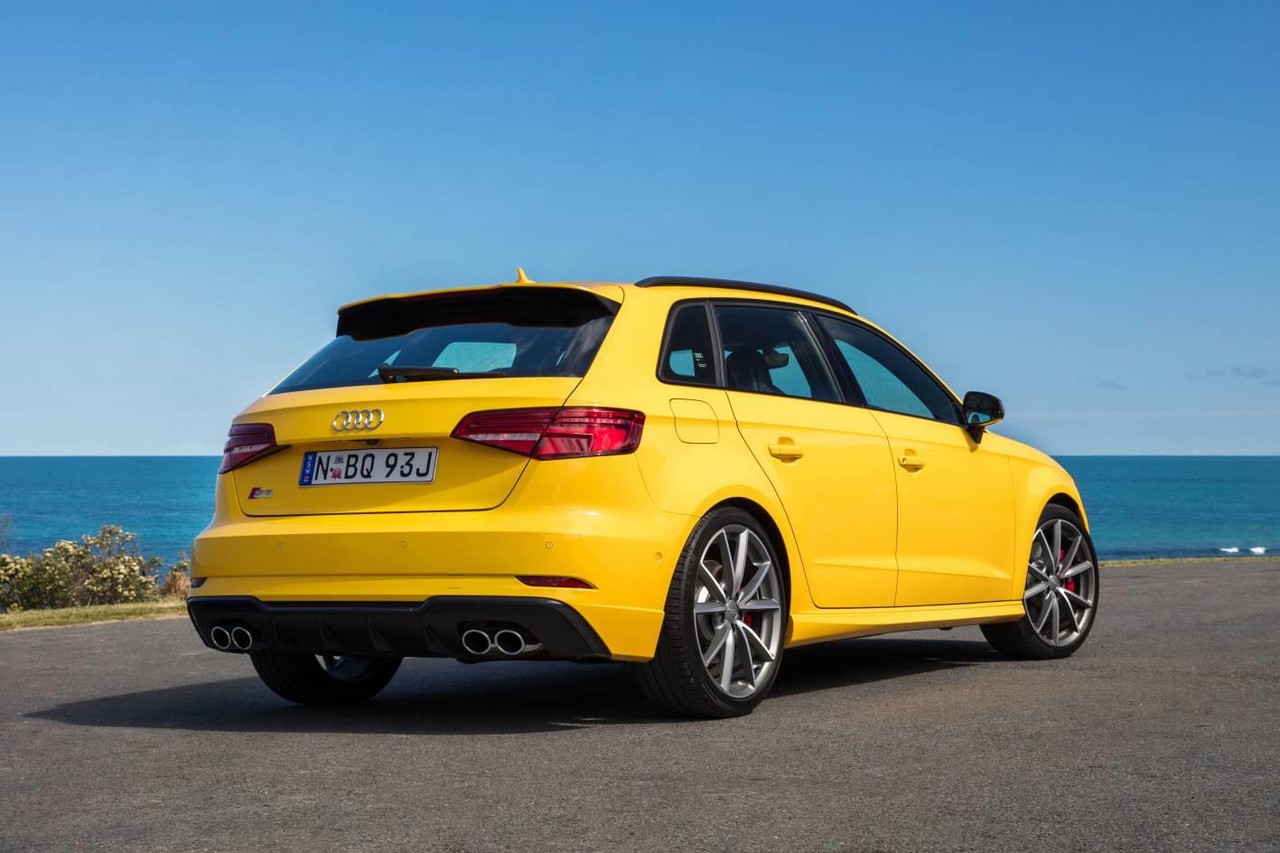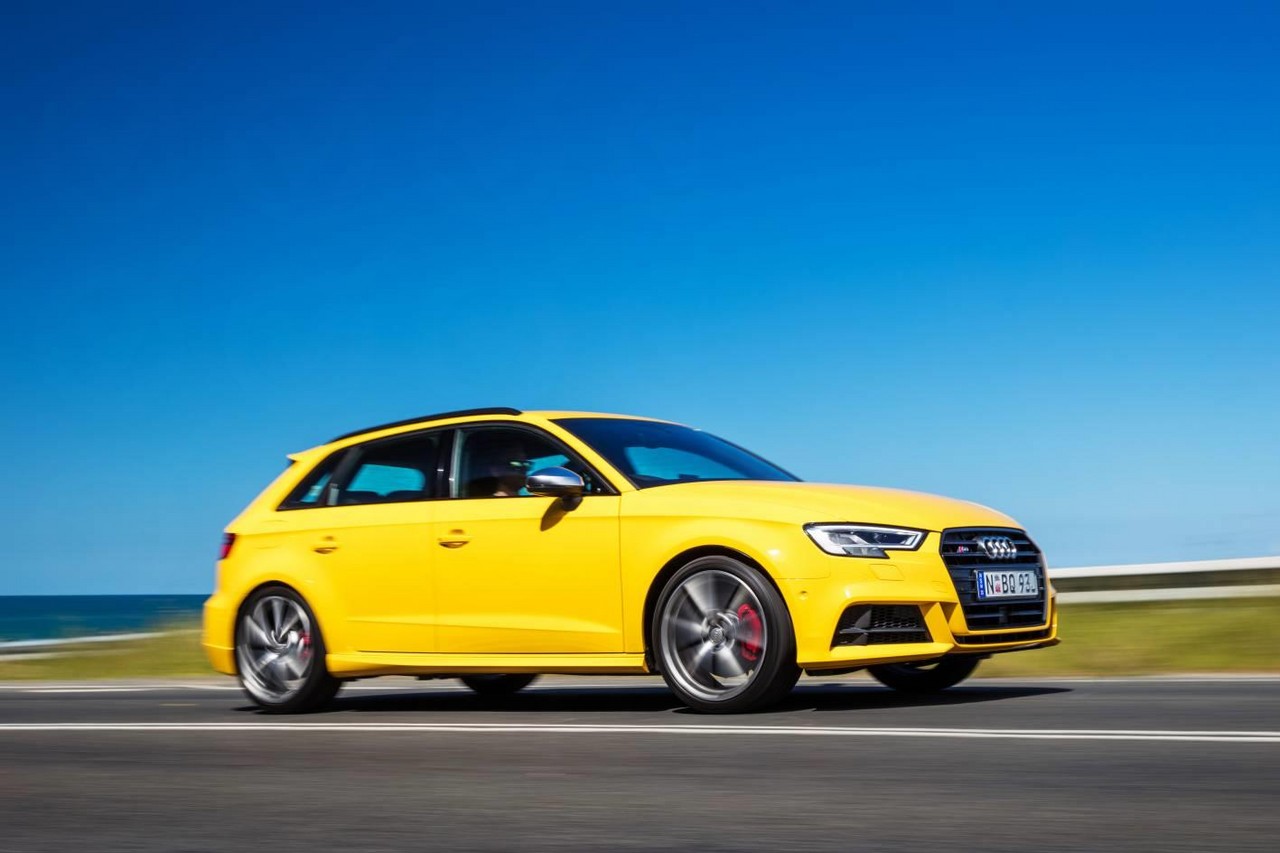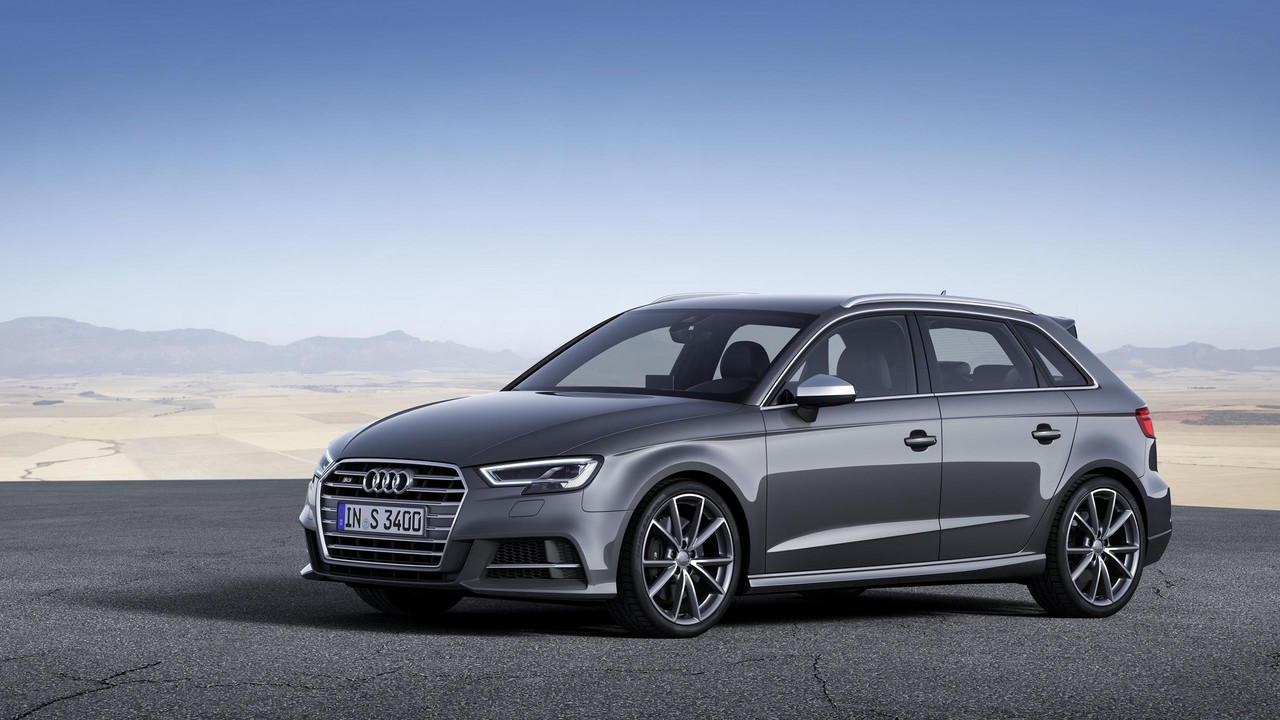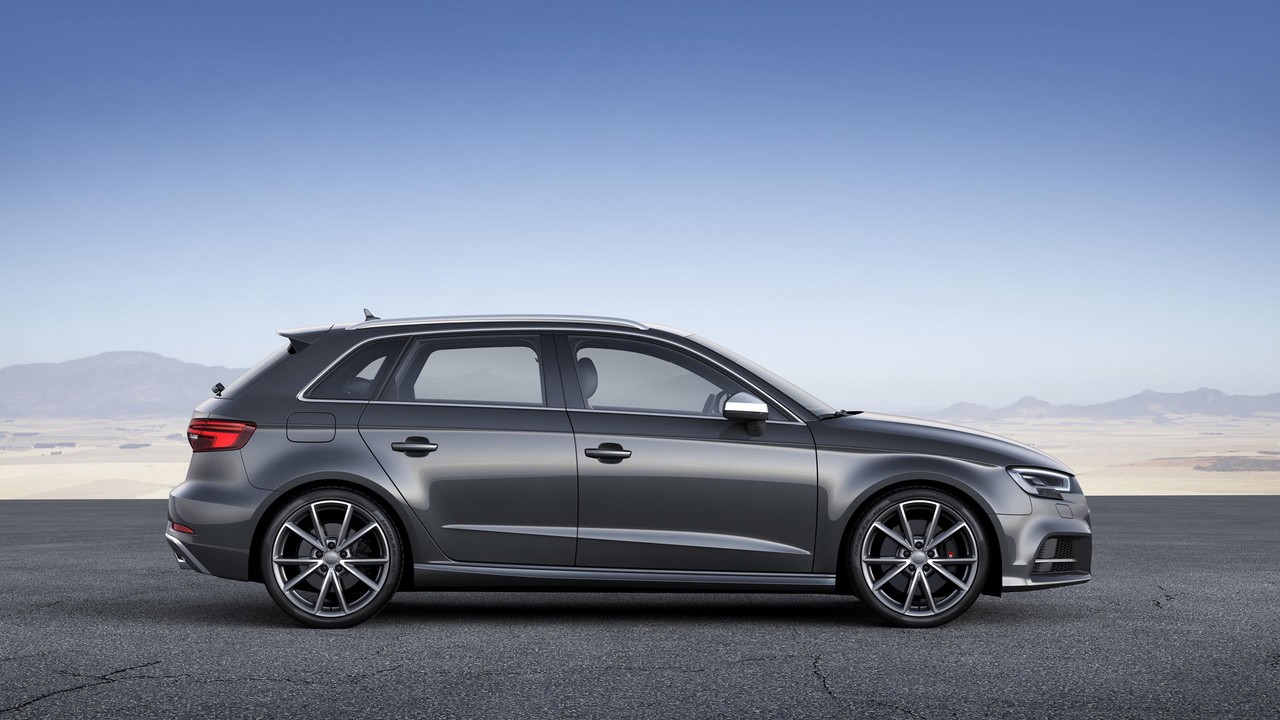
- Responsive 2.0-litre turbocharged petrol engine
- Excellent dynamics and agile handling
- Well-weighted and precise steering
- Turbo failure for pre-October 2014 Audi 8VA S3
- Firm ride
- Wind noise and tyre roar on coarse-chip bitumen
- Lacks outright performance of Mercedes W176 A 45 AMG
Review: Audi 8VA.I S3 Sportback (2013-16)
Overview
Released in December 2013, the Audi 8VA S3 Sportback was a small, five-door hatchback. Manufactured in Ingolstadt, Germany, the all-wheel drive Audi 8VA S3 Sportback was powered by a specially developed, long-stroke 2.0-litre petrol engine that was mated to either a six-speed manual or double clutch transmission (Audi’s ‘S-Tronic’).
CJXB engine
While the European Audi S3 was powered by Audi’s 221 kW CJXC engine, the Australian-delivered S3 was powered by the CJXB engine which had a lower peak output (206 kW or 210 kW). Attributes of the CJXB and CJXC engines included a grey cast iron block, a forged steel crankshaft which was induction hardened and had four counterweights, an aluminium-silicon alloy cylinder head, double overhead camshafts driven by gear chains, four valves per cylinder actuated by roller cam followers with needle bearings, variable intake and exhaust valve timing, variable exhaust valve lift, an IHI turbocharger which provided peak boost pressure of 1.2 bar (17.4 psi), direct and indirect fuel injection, and a compression ratio of 9.3:1.
The Audi 8VA S3 Sportback could accelerate from rest to 100 km/h in 5.0 seconds with the S-Tronic transmission and in 5.4 seconds when fitted with the manual transmission.
| Engine | Trans. | Peak power | Peak torque | Years | |
|---|---|---|---|---|---|
| S3 Sportback | 2.0-litre CJXB turbo petrol I4 |
6sp man., 6sp DCT |
206 kW at 5100-6500 rpm | 380 Nm at 1800-5500 rpm | 2013-14 |
| 210 kW at 5300-6200 rpm | 380 Nm at 1800-5200 rpm | 2014-16 |
quattro all-wheel drive
The Audi 8VA S3 Sportback had a fifth-generation Haldex all-wheel drive system which consisted of an electronically controlled and hydraulically actuated multi-plate clutch that was located in front of the rear axle differential (at the end of the prop shaft). Under low loads or when coasting, the rear axle was decoupled to minimise fuel consumption. If there was a loss of traction, or such a loss was anticipated by on-board sensors, the clutch would engage to transfer torque to the rear axle ‘in just a few milliseconds’ by forcing the plates within the clutch together.
Dimensions and suspension
Compared to the Audi 8P S3 , the 8VA S3 was 51 mm longer (at 4254 mm), 12 mm wider (1777 mm), 20 mm lower (1401 mm) and had an 18 mm longer wheelbase (2595 mm); kerb weight was 1520 kg. To limit the mass increase to 25 kg, the 8VA S3 used hot-shaped, high-tech steels for the bodyshell and the extensive use of aluminium for the front subframe, front axle pivot bearings, front fenders and bonnet.
Like its predecessor, however, the 8VA S3 had MacPherson strut front suspension and four-link rear suspension (with sword-shaped trailing links for propulsion and braking forces and three wishbones per wheel for lateral forces).
Safety equipment
Standard safety equipment for the Audi 8VA S3 Sportback included dual front airbags, a driver’s knee airbag, front side airbags, full-length curtain airbags, ABS, electronic brake force distribution, brake assist, electronic stability control, traction control and fronts seatbelts with pre-tensioners and load limiters.
As an extra-cost option, the Assistance package included:
- Adaptive cruise control (ACC): radar-based cruise control which could maintain a preset distance from the car ahead. For models with the S-Tronic transmissions, ACC included a ‘stop & go’ function for stop-start traffic;
- Side assist: a blind spot monitoring system which monitored lane changes via a rear-facing radar;
- Active lane assist: helped drivers remain in their lane by making slight steering corrections via the electromechanical steering if necessary; and,
- Pre-sense basic: if the vehicle lost traction, the S3 would prepare for an accident by tensioning the front seatbelts and closing the windows (and sunroof if fitted); and,
- High-beam assist: adjusted the output of the xenon headlights to avoid dazzling oncoming traffic.
Euro NCAP testing
In Euro NCAP testing , the related three-door Audi 8V1 A3 received a five star safety rating which included a 95 per cent adult occupant protection rating and an 87 per cent child occupant protection rating. In the front offset crash test, occupant protection was generally good, though chest protection was rated as adequate for the driver. Maximum points were awarded in the side impact test though, in the more severe pole test, chest protection was rated as adequate. Under ANCAP’s methodology , this testing resulted in a five star adult occupant protection rating with a score of 36.41 out of 37.
Brakes
The Audi 8VA S3 Sportback had 340 mm by 30 mm ventilated front disc brakes and 310 mm by 22 mm ventilated rear disc brakes.
Features: Audi 8VA S3 Sportback
Standard features for the Audi S3 Sportback included 18-inch alloy wheels with 225/40 R18 tyres, a 180 watt sound system with ten speakers (including subwoofer) and a six-channel amplifier, Audi’s MMI navigation plus system with a seven-inch colour touchscreen, DVD player, two SDHC memory card readers, 20GB HDD and voice recognition, dual-zone climate control air conditioning, power adjustable and heated front seats, fine Nappa leather upholstery, cruise control, xenon headlights, daytime LED running lights, front and rear parking sensors, a reversing camera, automatic headlights, rain-sensing wipers, Bluetooth connectivity, a leather-wrapped steering wheel (with gearshift paddles for the S-Tronic transmission where fitted), remote central locking with proximity key, power windows and mirrors, tilt and telescopic steering column adjustment, tyre pressure monitoring, a trip computer, an alarm and immobiliser.
S Performance package
The optional ‘S Performance’ package included 18-inch alloy wheels with an anthracite finish, a 705 watt Bang & Olufsen surround sound system with 14 speakers (including subwoofer) and a 15-channel amplifier, ‘S Sport’ front seats with diamond patterned stitching and integrated head restraints, LED headlights, black 3D inlays and ‘S design’ red brake calipers.
The S Performance package also included ‘Audi magnetic ride’, an electromagnetic damper control system. The damper control system used synthetic hydrocarbon oil which contained small magnetic particles and circulated within the damper pistons. When a coil applies a voltage, the magnetic particles would align perpendicular to the direction of the oil flow, impeding its flow through the channels in the pistons. The Audi magnetic ride system also enabled the driver to select from three selectable settings.
Related links
- Press Kit: Audi 8VA S3 Sportback (December 2013)
- Specifications: Audi 8VA S3 Sportback (December 2013)
Review: Audi 8VA.II S3 Sportback (2016-20)
Overview
Commencing production in May 2016 and officially released in Australia in November 2016, the Audi 8VA Series II (8VA.II) S3 Sportback introduced cosmetic updates and autonomous emergency braking (AEB) as standard. For the 8VA.II S3 Sportback, unique calibrations were introduced for the electronic stability control and multi-plate clutch all-wheel drive system, with the latter providing ‘more frequent and pronounced torque distribution to the rear axle.’
Visually, the Audi 8VA.II S3 Sportback could be identified by its wider single-frame grille with which had sharper contours, flatter headlights (bi-xenon units as standard) with jagged bottom edges and new tail-lights. Inside, there were revised air conditioning vents, while the ‘Audi virtual cockpit’ – which replaced the analogue instrument dials with a 12.3-inch TFT screen – was available as an extra-cost option as part of the Technik package.
While the engines of European-delivered S3 Sportback vehicles produced peak outputs of 228 kW at 5500-6500 rpm and 400 Nm at 2000-5400 rpm, outputs were lower for Australian-delivered vehicles.
| Engine | Trans. | Peak power | Peak torque | |
|---|---|---|---|---|
| S3 Sportback | 2.0-litre turbo petrol I4 |
6sp man., 6sp DCT |
213 kW at 5400-6500 rpm | 380 Nm at 1850-5300 rpm |
Safety equipment
For the Audi 8VA.II S3 Sportback, standard safety equipment was extended to include –
- Audi pre-sense city with Autonomous Emergency Braking (AEB) and pedestrian detection: operating at speeds up to 85 km/h, Audi pre sense city used a windscreen-mounted front camera to scan the road for other vehicles and pedestrians. If there was a risk of a collision, the driver would receive a series of warnings and, if the driver failed to respond, full braking force would be applied autonomously. At initial speeds of up to 40 km/h, collisions can be prevented; at higher speeds (up to 85 km/h), the severity of the collision would be reduced;
- Audi pre sense basic: in the event that a collision was anticipated, pre sense basic initiated occupant protection measures such as electric tensioning of the seatbelts and closing of the windows and sunroof (where fitted);
- Audi side assist: operating at speeds above 15 km/h, Audi side assist used the two rear radar sensors to monitor traffic up to 70 metres behind the Audi A3 Cabriolet. If another vehicle approached quickly or was in the driver’s blind spot, a warning LED in the housing of the appropriate door mirror would illuminate. If the driver activated the indicator to change lanes, the LED would blink rapidly to warn the driver; and,
- Attention assist: monitored driver behaviour for signs of inattentiveness and would provide a warning tone and visual signal if detected.
Assistance package
As an extra-cost option, the Audi 8VA.II S3 Sportback could be specified with an ‘Assistance package’ which included –
- Adaptive Cruise Control (ACC): using two front radar sensors and the camera, ACC could maintain a specified distance – from five distances – between the A3 Cabriolet and the vehicle ahead. Furthermore, ‘Audi drive select’ could be used to adjust the rate of acceleration and other control dynamics;
- Stop&Go function: an extension of ACC, ‘Stop&Go’ operated at speeds of 60 km/h to apply the brakes and bring the vehicle to rest. Once traffic began moving, the Audi S4 would automatically accelerate;
- Traffic-jam assist: another extension of ACC, the traffic-jam assist function could take control of steering operations at speeds up to 65 km/h on ‘well-developed roads when traffic is congested.’ In doing so, traffic-jam assist used the lane markings and other vehicles on the road for orientation. When the traffic-jam assist function reached its limits – for example, when traffic is sparse or there is a sharp corner ahead – the driver had to take over steering. Hence, the system provided warnings at different levels;
- Audi pre-sense front: scanned the road for vehicles when travelling at speeds up to 200 km/h and for pedestrians when travelling at speeds of up to 65 km/h. If there was a risk of collision, the driver would be warned and partial braking would be initiated automatically. If the collision risk persisted, full braking could be initiated (i.e. autonomous emergency braking or AEB);
- High beam assist: automatically switched between low and high beam headlights for improved visibility, using a sensor to determine when it was safe to do so (i.e. without dazzling other drivers);
- Audi active lane assist: operating at speeds of 65 km/h and above, Audi active lane assist used the front camera to recognise lane markings. As the vehicle approached a lane marking without the turn signal having been activated, the system provided a slight steering intervention to direct the vehicle back into its lane. Through the MMI system, the driver could select whether this intervention occurred at an early stage (in which case the vehicle was steered to the centre of its lane) or only shortly before crossing the line. The steering wheel could also vibrate as a warning signal if selected;
- Cross traffic assist rear: when reversing at low speeds, rear cross-traffic assist used the rear radar sensors to detect approaching traffic. If approaching traffic was detected which may cross the vehicle’s path, the driver received warnings (visual, acoustic and a brief, jolting application of the brakes); and,
- Hold assist: would automatically apply the brakes when the vehicle was stationary to prevent it from rolling as the driver moved their foot from the brake to the accelerator.
Features: Audi 8VA.II S3 Sportback
Compared to the 8VA.I S3 Sportback, standard features for the Audi 8VA.II S3 Sportback were extended to include a digital radio tuner (DAB+), the ‘Audi smartphone interface’ which provided Apple CarPlay and Android Auto smartphone integration via the USB port, LED headlights and ‘park assist’ which provided automated steering for parallel or perpendicular parking manoeuvres while the driver controlled vehicle speed.
Matrix LED headlights
As an extra-cost option, the Audi 8VA.II S3 Sportback could be specified with ‘Matrix LED’ headlights which used fifteen LEDs each produce a high beam that radiated from three reflectors. Using information from the forward-facing camera, their control module could turn them on or off individually, or dim them in 64 stages.
Specifications
Related links
